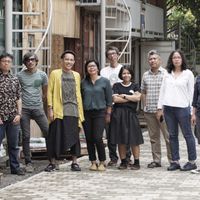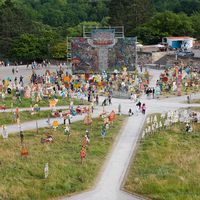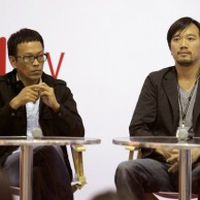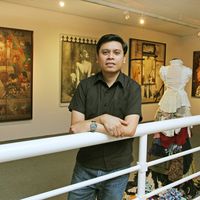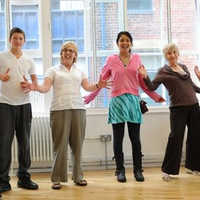Interview with Farid Rakun from ruangrupa | Indonesia
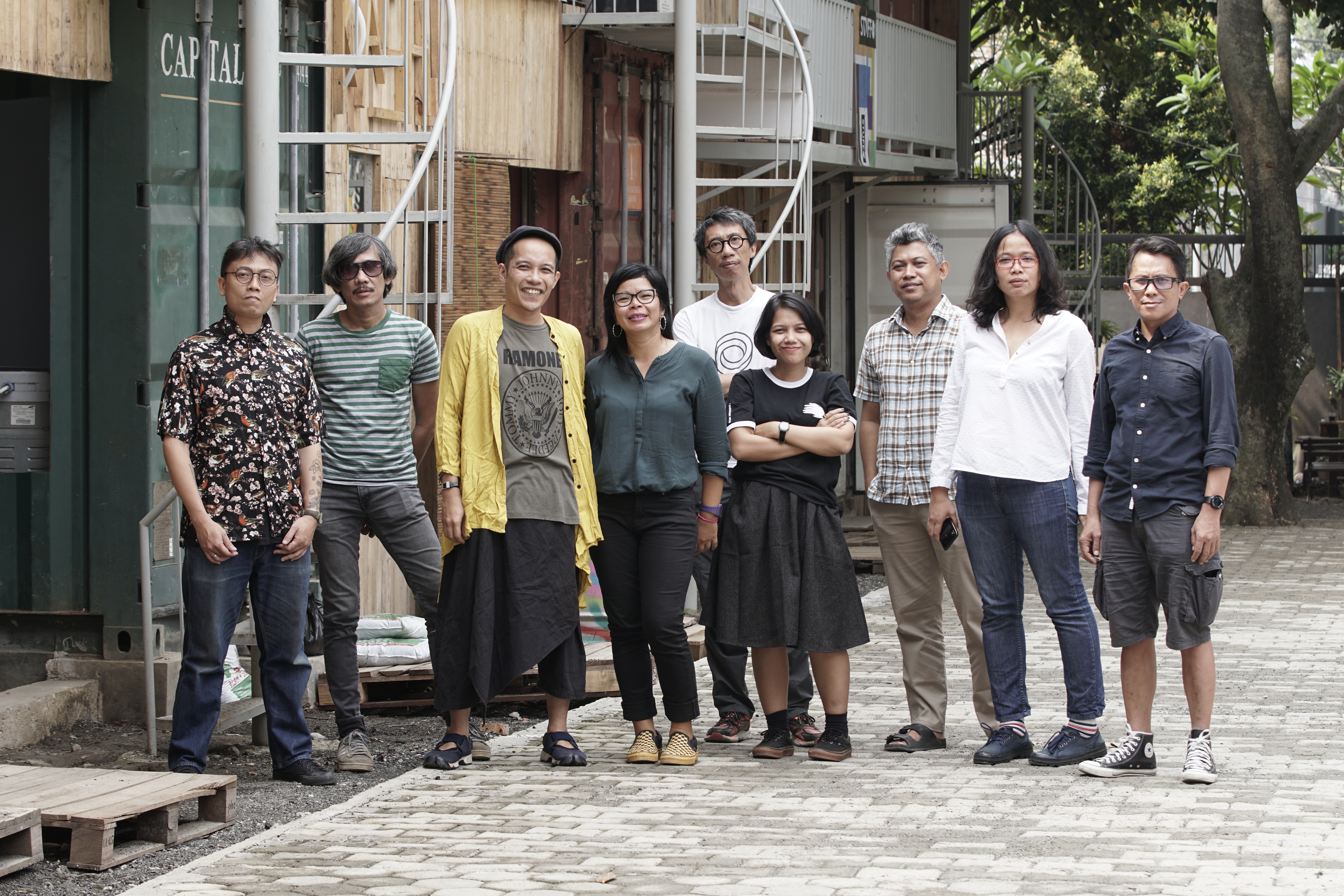
culture360.ASEF.org features the artists’ collective ruangrupa, from Jakarta. In this article, Katerina Valdivia Bruch interviewed Farid Rakun, one of the members of ruangrupa, on topics around collective practice, the role of art in society and the next documenta.
Farid Rakun: "It is important to go back to what makes us humans".
The artists' collective ruangrupa, from Jakarta, has been appointed artistic director of the upcoming documenta fifteen, which will take place in Kassel in 2022. The collective, established in 2000, has been organising several events in Indonesia and overseas. Among their established events in Jakarta are the Jakarta International Video Festival OK.Video (since 2003), the student programme Jakarta 32°(since 2004), and some editions of the Jakarta Biennale. Since 2018, they run GUDSKUL, what they understand as “the collective of collectives” and describe it as “a public learning space”.
As a collective, ruangrupa has participated in several biennales and international exhibitions, such as Gwangju Biennale (2002 and 2018), Istanbul Biennial (2005), Asia Pacific Triennial of Contemporary Art (Brisbane, 2012), Singapore Biennale (2011), São Paulo Biennial (2014), Aichi Triennale (Nagoya, 2016) and the exhibition Cosmopolis at Centre Pompidou (Paris, 2017). In 2016, they curated TRANSaction for the Sonsbeek exhibition in 2016 (Arnhem, NL).
Farid Rakun: FR
Katerina Valdivia Bruch: KVB
KVB: The idea of collaboration has been present in the majority of ruangrupa’s projects. What is going to happen to the activities you were doing during the year, now that the collective has been appointed artistic director of documenta fifteen? Are they going to continue?
FR: In 2018 we became GUDSKUL (Good School) that is understood as the collective of collectives. After being appointed to become artistic directors of the next documenta, one of the things we were thinking was how to sustain our current programmes. After some discussions, we came to the conclusion that we would like to continue them. That's our goal. If we will make it or not, that's what we are going to see. We will make sure that we continue what we already started.

Farid Rakun (Photo Credit: Gudskul/ Jin Panji, 2019)
KVB: I think that some of these projects might be able to maintain themselves, because you already have a group of people working on them. When I was at the OK. Video Festival and the Jakarta Biennale of 2009 (both were organised by ruangrupa that year), I liked the fact that you were mobilising different communities. Some people would even start different projects out of what you proposed. For me, it was as if the spirit of ruangrupa was in the air. With your events, you were activating the whole city. You put art in non-artistic environments. For instance, part of the Jakarta Biennale was happening at the shopping mall Grand Indonesia, or some videos of the OK. Video Festival were screened in train stations.
FR: I think it is more the Jakarta spirit, and ruangrupa is part of this spirit. That's why it is quite easy to work the way we do.

Jakarta 32°, 2010. (Photo Credit: ruangrupa)
KVB: In the last years, some major art events have been curated by artist collectives, such as the Shanghai Biennale in 2017 that was curated by Raqs Media Collective. And now, ruangrupa is artistic director of the next documenta. Are the artists the new curators?
FR: In our case it is quite clear. We became curators not because we wanted to take that role from the beginning. None of us learned how to become curators. It was something that came out of necessity. We needed it. We run festivals, we run lots of different events and initiatives and we needed to curate them. We learned it by doing it as part of our artistic practice. What we cannot do is to become or curate like those who were trained to be curators. We have to be honest. We don't have that sensibility. We are not trained that way.
What we know is how to curate our own way, which is coming from a different place. Whether it is called curating or not, it depends on how people understand it. There are certain things that we need to do that lots of curators would never do. And, on the other hand, there are things curators need to do and we don't. For us, the words 'artist' or 'curator' are just labels, and these are very fluid. If you think about it, throughout decades, even centuries, artists curated out of necessity.
KVB: Specially in Indonesia, where a great part of the arts scene since the early 1990s has grown out of grassroots artists' initiatives. The artists were the ones setting up the institutions that were lacking. Today, things have changed. There are already a number of art institutions, but initially that was not the case. Artists had to make things from scratch.
When I was in Indonesia, I remember that one of ruangrupa's focus area was the idea of the city and the urban environment. This time, for documenta, you have chosen the rice barn (lumbung) as a topic.
As far as I know, rice barns in Indonesia usually are constructions made with bamboo and/or wood, which are built on stilts a bit higher than the floor (around 1,50 or 2 metres below it). On top of it there is space to store the harvest, and below you will find a shady space in which people can sit and relax. This space might also be used to meet and socialise, or even to talk about business. What does the rice barn mean in the context of an international exhibition such as documenta?
FR: We use the rice barn concept as a frame of thought. For us, it is a collective pot. So far, we have been practising it in here as GUDSKUL. The rice barn principle is the way we talk to each other about what we are going to do.
The term lumbung is still useful for us at the moment. We will see how long we will be using it, maybe we will drop it, maybe not. It is still an abstract idea and we are still experimenting with it. Important for us is the understanding of putting a lot of things in one pot. For instance, all that we deem to be resources: space, time, equipment, skills, knowledge, even networks, and money, of course. If you put all these elements together, then we are able to share them. How can we practice this way of understanding collectivity? This is something we are trying to figure out.
Before we brought it to documenta, we were already practicing this idea in Jakarta and later during the Sonsbeek exhibition we curated in 2016. The idea is that the concept of the rice barn becomes planetary. Let's see if that is possible.
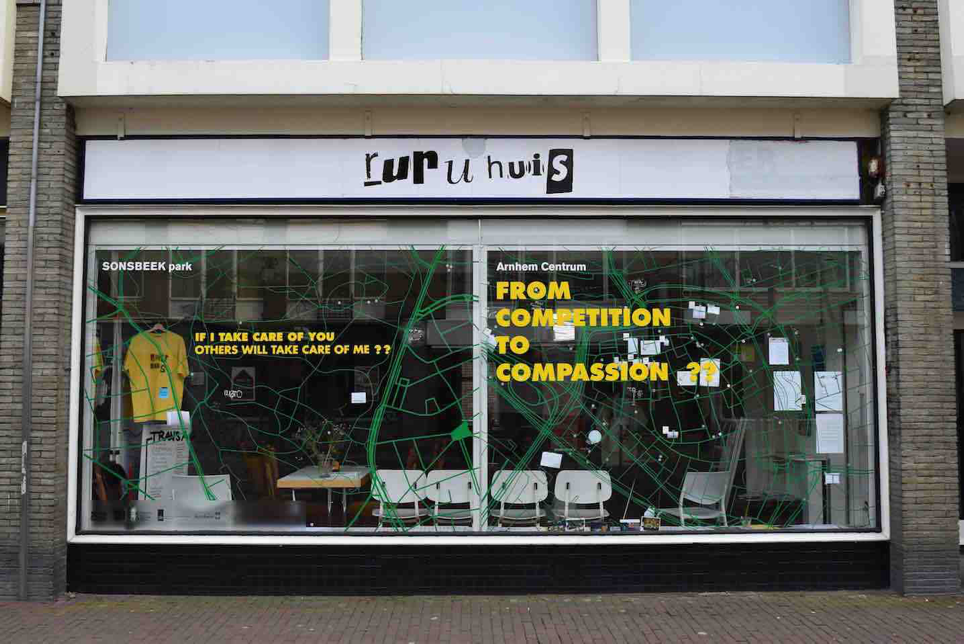
ruru huis at Sonsbeek ’16: TRANSaction. (Photo Credit: ruangrupa)
KVB: I was thinking about the architecture of the rice barn. It is not exactly on the ground. It is slightly a bit up. There is a little space between the ground and the structure, and then you have the deposit on the top part.
FR: Actually, this in-between space is very interesting, as it becomes a social space. It is similar to the modern idea of understanding the pilotis space by Le Corbusier or Mies van der Rohe, when they came up with the concept of an undefined free space under a building to act as a public space. In Indonesia, this idea was already there in vernacular architecture. Although it has another meaning, the use of the space is quite similar. And this kind of meeting space is useful for us. It is an excuse to meet more people, to have more friends. To have a roof on top of us that happens to hold certain resources. And, exactly because of that, we can do what we do below it.
KVB: I have been following some exhibitions in the last years and there is a tendency to consider the collectivity as the solution to many social and political concerns. Living in Germany for 20 years made me think that collectivity can be something good in terms of social relations and networks of solidarity, for instance if we think about initiatives for better housing conditions or sustainable networks, that support ecologist activities; but it might be also negative, if we think about radical right-wing movements.
While I was in Indonesia, I could see that collective work is something quite common. In a conversation I had with the artist Jompet Kuswidananto he said: “Community is in our DNA.” How do you expect to spread this positive spirit of ruangrupa’s collective work to an urban context, in which networks happen more and more online, and less in real life?
FR: Collectivity is not the answer for everything, I would say. It's not a magic pill, because it all depends on the target. If you want to do something fast and productive, then it is much better to work with a company. That's just clear. Collective work is not the most effective, efficient, or even productive way of doing things. There are lots of forms of collectives. For instance, the army, which is also another type of collective. Politically speaking, from the left to the right there are a number of different collectives. There is not one way to understand them. We know our own way to understand it. We became this kind of collective, because of where we are and where we came from.
I think there is a danger to romanticise collectives, especially when it becomes a trend, which is the danger right now. But hopefully it is not like another trend. If you think about community building, technology offers another type of collectives that treats individuals differently, which is also something we can learn from. If you think about the young generation, for example, they have a different way of understanding reality, as there is almost no separation between what is real and what is virtual. They socialise and relate to each other differently. I think that it has a lot of consequences. Collectivity also grows through technology.
For us, it is important to go back to what makes us humans. We want to turn our attention to human beings and their qualities, to make sure that we are not only numbers. When we become numbers, we get reduced to become something else. I think, it is valuable to come up with human values again, such as fun, humour, or spending time together. It is very basic, but a lot of things have not been running in this way. They were not based on these values.
KVB: This point makes me think about your presentation at the Institut national d’histoire de l’art in Paris (16 November 2019). You were speaking about “stories, not theories”, as one of the main ideas of ruangrupa for the next documenta. Is this idea connected to living, experiencing art, instead of theorising about it? Which kind of stories are you looking for?
FR: We get a lot of questions about postcolonial debates, decolonisation, and other topics coming from certain theories or standpoints. They are useful to a certain extent. But, to be honest with you, for us it's like talking about real politics. It constrains the way we work, as we don't exist as a collective through these theories. What we know is that all of us has his/her own stories. For us it is a communication strategy and for us it is useful to think that way.
We are not going to come up or try to illustrate theories. Actually, the theories of the contemporary are already happening. What we are trying to do is to let stories come up, such as fairytales, fables, or even fictions. They are telling you something, but in a different way. The response is different. You can theorise about utopia and dystopia in an academic way, which has its own use. But you can also reflect on things by reading “1984”, science fiction books, or by watching the movies “The Matrix” or “Her”, for example.
For us, our choice of communication is storytelling, instead of theorising. It can be based on living experiences. For instance, when we were kids, we listened to bedtime stories before going to sleep. Through these, we absorbed certain values that we might have translated in our real life. Stories are not prescriptive. They don't tell you how to live, but there are still certain values that you can remember. You are the one who chooses how to translate them in your everyday life. That's why storytelling is interesting for us.
KVB: Let's come to the last question, which is a broad one. What is the role of art in society? Do you believe in the transformational role of the arts?
Farid: It's really difficult for us to answer this question, as for us Indonesians there is no clear separation between life and art. If you go to Bali, for example, you see the creative part of everyday life in the way they do their housing or in the daily religious rituals. People see this as a complete thing. There is no such thing as “art for art's sake” in my everyday ecosystem. And as a consequence, it is very difficult for artists around me to understand this idea.
Of course, art has a transformational role, but we don't really think about it. We are doing radio or karaoke, for example. Would you call it art? We actually don't know how we would define it. We are almost miming the everyday. All that we do is part of our artistic practice. We cannot separate life from art. Where is work? Where is life? Even for me it is quite confusing sometimes. If this is work, then it is so a lot of fun. The answer to your question is yes, but we don't ask ourselves this question. We just do!
Trained as an architect (B.A. in Archictecture from Universitas Indonesia and M.A. in Architecture from Cranbrook Academy of Art), Farid Rakun has been a visiting lecturer at the Architecture Department of Universitas Indonesia. He is member of the artists’ collective ruangrupa, with whom he co-curated TRANSaction: Sonsbeek 2016 in Arnhem, NL. As an instigator, he has permeated various global institutions such as Centre Pompidou, La Biennale di Venezia, MMCA Seoul, Sharjah Biennial, Bienal de São Paulo, Harun Farocki Institut, Dutch Art Institute (DAI), Creative Time, Haute école d'art et de design (HEAD) Genève, and basis voor actuele kunst (BAK). He has worked for Jakarta Biennale in different capacities since 2013 and currently serves as its interim director.
Katerina Valdivia Bruch is a Berlin-based independent curator and arts writer. She has curated exhibitions and organised several talks, symposia and lectures on Indonesian art in Germany (among them Kunstmuseum Bonn and Bielefelder Kunstverein), Mexico (Instituto Cultural de León), Hong Kong (Para Site) and Singapore (Institute of Contemporary Arts Singapore).
In 2011, she curated the lecture and video programme Moving Images from Indonesia, as part of the programme Curating in Asia of the exhibition The Global Contemporary: Art Worlds after 1989 at ZKM - Centre for Art and Media Karlsruhe.
Additionally, she has published several articles, essays and interviews on Indonesian art, and contributed to a number of exhibition catalogues, such as Mediatopia: Krisna Murti's Works (1999-2010) on the work by video pioneer Krisna Murti, published by Semarang Art Gallery. The focus of her research and curatorial residencies in Indonesia were on artists' collectives (curatorial residency at MES 56), performativity in the visual arts and video art (Indonesian Visual Art Archive), and censorship in the visual arts in Indonesia after 1998 (Langgeng Art Foundation). www.artatak.net
Links:
ruangrupa: http://ruru.ruangrupa.org/
GUDSKUL: https://gudskul.art/
documenta: https://www.documenta.de/en/
Sonsbeek: http://www.sonsbeek.org/en/about/
Cover image of ruangrupa. (Photo Credit; Gudskul/Jin Panji, 2019)
Similar content
posted on
25 Feb 2019
from - to
18 Jun 2022 - 25 Sep 2022
15 Apr 2008

